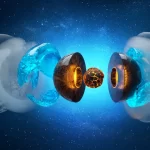Key Takeaways:
- Recent studies suggest the existence of human-safe wormholes, challenging long-standing skepticism.
- Theoretical models propose methods to prevent the collapse of wormhole necks without exotic matter.
- Microscopic wormholes, though not traversable by humans, represent a significant theoretical advancement.
- Theoretical wormholes large enough for human transit are explored, involving five-dimensional spacetime.
- Practical limitations, including cleanliness and generation, remain significant challenges in wormhole theory.
Sci-fi enthusiasts have long been enamored with the idea of wormholes, seeing them as a conduit for swift interstellar travel. However, their existence has remained purely speculative. That is, until March 2021 when groundbreaking studies published in esteemed journals suggested that wormholes safe for human passage may indeed exist in reality.
Central to the skepticism regarding wormholes is the notion that their narrowest segment, known as the neck, would likely succumb to gravitational forces. One proposed solution involves filling the wormhole with exotic matter of negative mass. Unfortunately, this matter is purely theoretical, leaving the concept in the realm of speculation.
The first paper, led by Jose Blázquez-Salcedo of the Complutense University of Madrid, introduces an innovative approach to preventing the collapse of a wormhole’s neck. Their theoretical framework delves into the potential of microscopic wormholes, drawing from three fundamental theories: relativity, quantum mechanics, and electrodynamics.
The crux of their proposal lies in adjusting the mass and charge of fermions, elemental particles composing matter. This strategy hinges on a specific ratio between the total charge of fermions and the aggregate mass within the wormhole, surpassing the limit set by black holes.
It is worth noting that Blázquez-Salcedo’s team primarily discusses microscopic wormholes, not immediately traversable by humans. Nevertheless, this marks a significant stride in a promising theoretical direction.
The second paper, authored by Juan Maldacena and Alexey Milekhin, presents a wormhole concept accommodating human passage. This wormhole, existing in five-dimensional spacetime according to the Randall-Sundrum model, would appear akin to intermediate-mass black holes to a casual observer.
However, there are practical challenges. A journey through this type of wormhole would involve experiencing up to 20 Gs of acceleration – a potentially uncomfortable yet survivable ordeal. The wormhole must also be impeccably clean, devoid of stray particles. Furthermore, it must be extremely cold, adding to the complexity of its creation.
João Luís Rosa, a physicist at the University of Tartu, Estonia, offers an alternative approach. His paper introduces the concept of “generalized hybrid metric-Palatini gravity,” which requires no exotic matter. This model builds upon general relativity, albeit with nuanced relationships between matter, energy, space, and time.
In this framework, a stable wormhole can be constructed by layering the entrance with double thin shells of regular matter. This shifts the paradigm away from the need for negative energy or mass.
In conclusion, the theoretical promise of wormholes suggests that a cross-galaxy voyage could take less than a second from the traveler’s perspective. However, for those tracking the journey from the outside, it could span tens of thousands of years. Thus, finding a return trip might be a personal endeavor.


